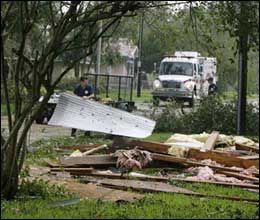By Maveric Vu
EMS1 Staff
 AP Photo/Matt Slocum Morgan City first responders clear debris from a street after Hurricane Gustav, Tuesday, in Morgan City, La. Many residents faced medical emergencies due to dehydration, lack of medication and roadway accidents. |
Paramedic Kelly Grayson stood ready as he witnessed thousands of refugees migrate to northern Louisiana in the aftermath of Hurricane Katrina in 2005.
His recollection of the disaster is encapsulated by one particular patient — a comatose man presenting with renal failure with a message scribbled by a doctor on the back of a water bottle receipt that read, “For God’s sakes, someone dialyze me.”
Vivid memories of Katrina played a large role in the emergency response to the weaker-than-expected Hurricane Gustav, as nearly 2 million people fled the Louisiana coast Monday due to mandatory evacuation orders. With levees remaining intact, residents are now trickling back to their homes as rescue teams survey the destroyed areas.
“We were seeing the same things from [Katrina], except on a smaller scale this time — a lack of preparedness, people with not enough water, people who forgot their medications,” said EMS1 columnist Grayson, who works for Acadian Ambulance in Louisiana.
Grayson was stationed just outside the hurricane’s path in Calcasieu Parish, located in southwest of the state. He assisted in transporting nursing home residents and handling the increased call volume.
While not as powerful as Katrina, Gustav had a significant impact on communications. About 30 transmission lines and dozens of substations were rendered offline, according to reports.
“We had radios, but all the high tech satellite communications and tracking equipment were on the fritz,” Grayson said. “We were not able to depend on technology and had to go back to the old-fashioned stuff.”
One of four major hospitals in the western Louisiana area was completely shut down, prompting doctors to only accept emergent patients during the duration of the storm.
“We were given permission — at least until the evacuation order was lifted — to do paramedic-initiated refusals, which is not a common thing for private ambulance,” Grayson said. “It’s important to remember that you’re not going to be able to do much medical treatment during the hurricane itself.”
By Thursday morning, it was reported Gustav’s death toll had reached 16 people, a stark contrast to the nearly 1,000 deaths reported from Katrina.
While not quite “scoop-and-run” tactics, Grayson mostly focused on transporting evacuees and BLS treatment. Downed power lines and felled trees on roadways caused significant delays in getting to patients, he said.
Grayson, who has worked three 16-hour shifts since Monday, said there are two key components to responding to a natural disaster: being prepared for the long hours and staying safe while in the field.
Prior to his shifts, Grayson stocked extra bandages, IV fluids and spine boards, as well as additional personal gear. He also followed strict protocols mandated by area operations supervisors to stand down when winds pick up beyond 40 mph.
“Ambulances turn into humungous kites when winds get high,” he said, “Much to the detriment of some of the medics.”
The National Hurricane Center in Miami said Gustav hit around 9:30 a.m. Monday near Cocodrie, a low-lying community in Louisiana’s Cajun country 72 miles southwest of New Orleans, as a Category 2 storm on a scale of 1 to 5. The stormed peaked at 110 mph and skirted New Orleans before weakening to a Category 1 storm later that afternoon.
Several rescue teams from around the nation have been deployed to aid recovery efforts. Members of New York City’s Task Force 1 were deployed early Saturday in response to the arrival of Gustav.
The team, which is comprised of 35 members of the FDNY, NYPD, FDNY EMS and OEM, also worked in the aftermath of Katrina.
There are 28 FEMA Urban Search & Rescue Task Forces in total strategically located throughout the United States, each trained and equipped by FEMA to respond to disasters.
“The experience that we gained from Katrina, deploying as a team, is really going to benefit us and has already made the team so much more prepared and ready for the potential mission that lies ahead,” said FDNY Rescue Battalion Chief Joe Downey.
As rescue teams congregate in the hurricane-hit areas, many residents are also returning home to assess potential damage after the evacuation order was lifted Tuesday.
EMS1 staff member Jamie Thompson contributed to this report.

